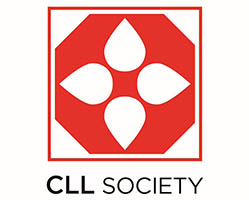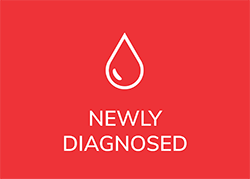In this video, Dr. Richard R. Furman, M.D, The Morton Coleman, M.D Distinguished Professor of Medicine at Weill Cornell Medical College, Columbia University (NYC) and Director of the CLL Research Center at New York-Presbyterian Hospital is interviewed by CLL Society founder and Chief Medical Officer, Dr. Brian Koffman, M.D., a retired family physician and a CLL patient. This video was recorded at the 61st Annual Meeting of the American Society of Hematology, in 2019, in Orlando, Florida.
The advent of ibrutinib (Imbruvica®), the first Bruton’s Tyrosine Kinase inhibitor (BTKi), has dramatically changed the treatment of chronic lymphocytic leukemia (CLL), in the last decade. Clinically we now see that 80% of patients do extraordinarily well on ibrutinib with a low rate of progression. The remaining 20% experience adverse effects including transformation to more aggressive lymphomas or resistance to ibrutinib.
Research continues to identify compounds that block BTK and have fewer side effects and potentially overcome resistance. This has led to the second generation BTKi drugs acalabrutinib (Calquence®) and zanubrutinib (Brukinsa®) which, at present, is only approved for mantle cell lymphoma (MCL). There are currently three third generation BTKi drugs in various stages of development including vecabrutinib (SNS-062), pirtobrutinib (Loxo-305) and nemtabrutinib (ARQ-531).
Takeaways:
At present there are two overall classes of BTKi drugs. The irreversible agents include ibrutinib, the first agent approved and thus considered as “first-generation” as well as two second-generation agents acalabrutinib and zanubrutinib. While currently zanubrutinib is approved only for MCL, it is being used in clinical trials for CLL. It should be noted that the other irreversible agents followed similar patterns of being approved either simultaneously or in short time period for both conditions. The latest BTK drugs under study, are the third-generation drugs, mentioned above. These three agents are classified as reversible agents.
At ASH 2019, Dr. Furman presented 4-year follow up data about acalabrutinib which began clinical trials in 2014. The abstract he presented was entitled: Acalabrutinib monotherapy in patients with relapsed/refractory chronic lymphocytic leukemia: updated phase 2 results. Dr. Furman discusses that it appears that clinically each generation of BTKi drugs show equivalent or better response compared to ibrutinib, and the major advantage of better tolerability appears to be found as well.
We now, know that the beneficial effects of all the BTKi agents are the result of the inhibition of Bruton’s Tyrosine Kinase (BTK) that is over-expressed in cancer cells and signals those cells to proliferate. While some of the side effects of ibrutinib are directly attributable to the inhibition of BTK, others are caused by inhibition of other kinases also found on the surface of CLL and other cancer cells.
Regarding two of the five most common adverse effects of ibrutinib, we now understand that ibrutinib blocks more than just BTK and, in fact blocks other kinases as well. Bruising, for example, is more common with ibrutinib which has been shown to not only block BTK but also completely blocks the entire family of Tec Protein Tyrosine Kinases (TEC), of which BTK is a member. Acalabrutinib, on the other hand, only incompletely blocks TEC and therefor the incidence of bruising is less. The incidence of diarrhea is also lower with acalabrutinib than with ibrutinib because ibrutinib impacts EGFR (epidermal growth factor receptor) protein, another member of the protein kinase family, while acalabrutinib does not and diarrhea is observed less frequently in patients on acalabrutinib. Dr. Furman mentioned, that with his patients who experienced diarrhea, if they switched ibrutinib to bedtime there was less incidence and severity observed.
The incidence of the other three most common side effects of ibrutinib, atrial fibrillation, hypertension and arthralgias (pain), occurs less with acalabrutinib, but the mechanism of why is not yet completely understood.
A portion of patients on first-generation or second-generation agents develop a mutation within their CLL cells where the cells become resistant to BTK blockade and the disease progresses. This mutation, which is detected through genetic testing, is known as the BTK C481S mutation and is the most common of several mutations that lead to resistance to a BTKi.
The third-generation, reversible agents have overcome this mutation and allow patients who had previously been resistant to a BTKi to regain inhibition of this signaling pathway. Early clinical trials of SNS-062 (vecabrutinib) show that it is effective not only against cells with the C481S mutation but also against the CLL cells that develop in nature that are known as “wild cells”.
Conclusions:
Because the BTKi drugs are not curative in most cases when used as monotherapy, the keys to success are durable response and tolerability to allow long term use to hold the progression of CLL at bay. It is encouraging that successive generations of BTKi drugs all show durable responses and that tolerability improves over time as new agents are developed.
Dr. Furman has found that approximately 80% of his patients do extremely well on ibrutinib and have extraordinarily low rates of progression. The remaining 20% may have some “genomic instability” that makes them more susceptible to toxicities, resistance or transformation. The availability of newer agents provides additional treatment options making the future of CLL treatment look bright.
Dr. Furman also provides additional hope to CLL patients in that he reports that data shows that the risk of infection goes down over time for patients on ibrutinib. Theoretically, ibrutinib diminishes immune function but clinically (in practice) physicians are seeing improved immune function over time. At this time, it is not completely understood if this is because there is a decrease in the number of CLL cells in the marrow and blood allowing other cells to grow, or if the deleterious effect of ibrutinib on T-cells is only found in the lab (in vitro) and not within the body (in vivo).
As with other advances in CLL treatment, the growing number of BTKi agents allows more options for physicians and patients to receive individualized care. In the future, approval of a third generation BTKis will add another option for dealing with resistance that is currently addressed with combination therapies such as ibrutinib + venetoclax, duvelisib + venetoclax, or umbralisib.
The link to find out where the Loxo-305 clinical trial is available and more information is: https://clinicaltrials.gov/ct2/show/NCT03740529 and the link for the ARQ-531 clinical trial is: https://clinicaltrials.gov/ct2/show/NCT03162536.
To learn more about clinical trials, in general, go to https://cllsociety.org/clinical-trials.
For more information about acalabrutinib , please enjoy my deeper review article, Things to Know about Acalabrutinib.
Thanks for reading this summary and viewing this interview.
Stay strong, we are all in this together!
Thomas. E. Henry III, MBA, RPh, CPh
Addendum: Since this interview, the development of vecabrutinib for use in CLL has stopped.
Thomas Henry is a Registered Pharmacist and CLL Patient. He is President and Senior Consultant for Burlington Consulting Associates, a company that provides consulting services to health systems nationwide. Tom is a CLL Society Medical Advisory Board member and strives to educate other CLL patients through his blog https://www.cllpharmacist.com. He has a forty-two-year career in pharmacy and has served as Chief Pharmacy Officer at two Top-15 Comprehensive Cancer Centers, Moffitt (Tampa, FL) and Roswell Park (Buffalo, NY).
















